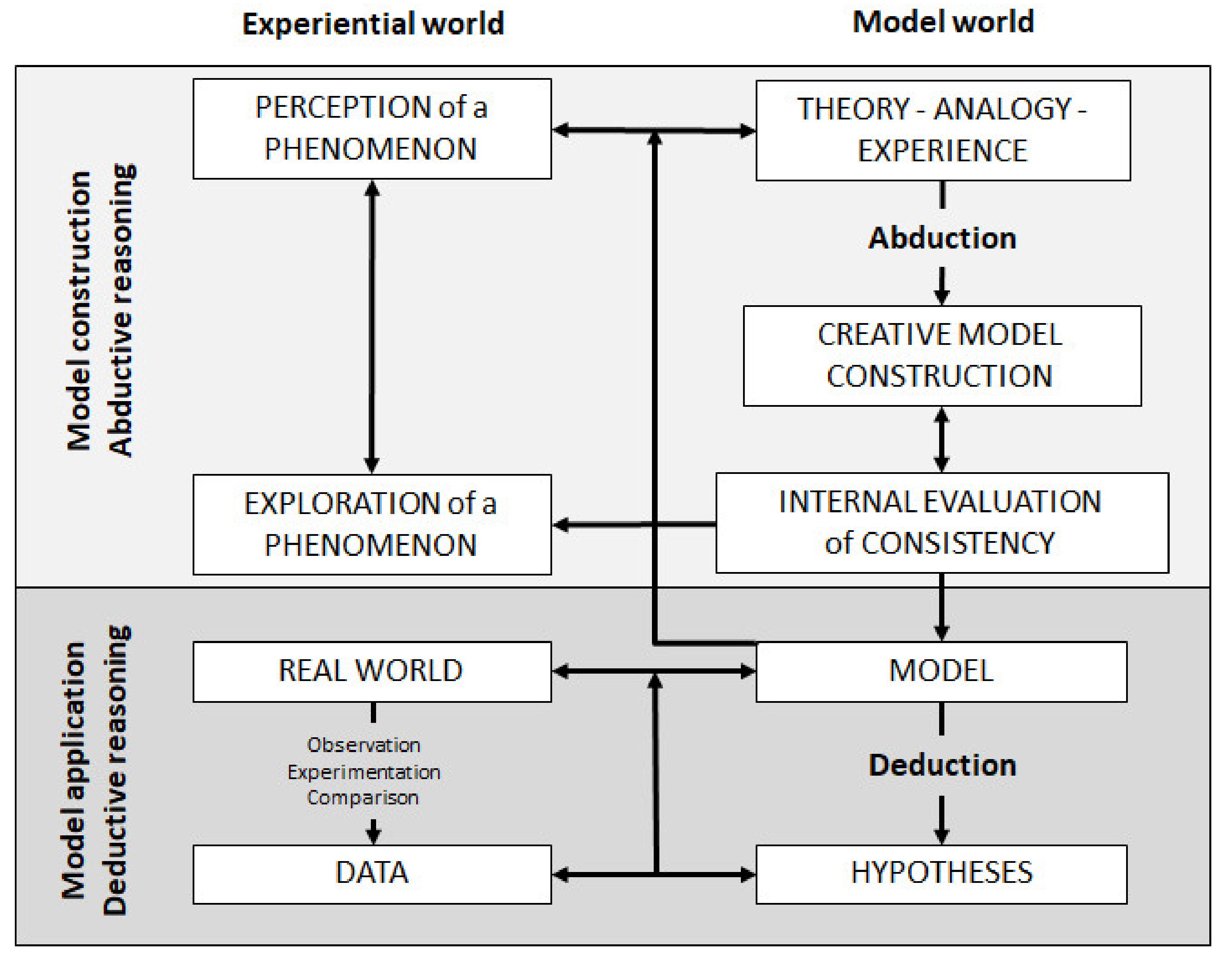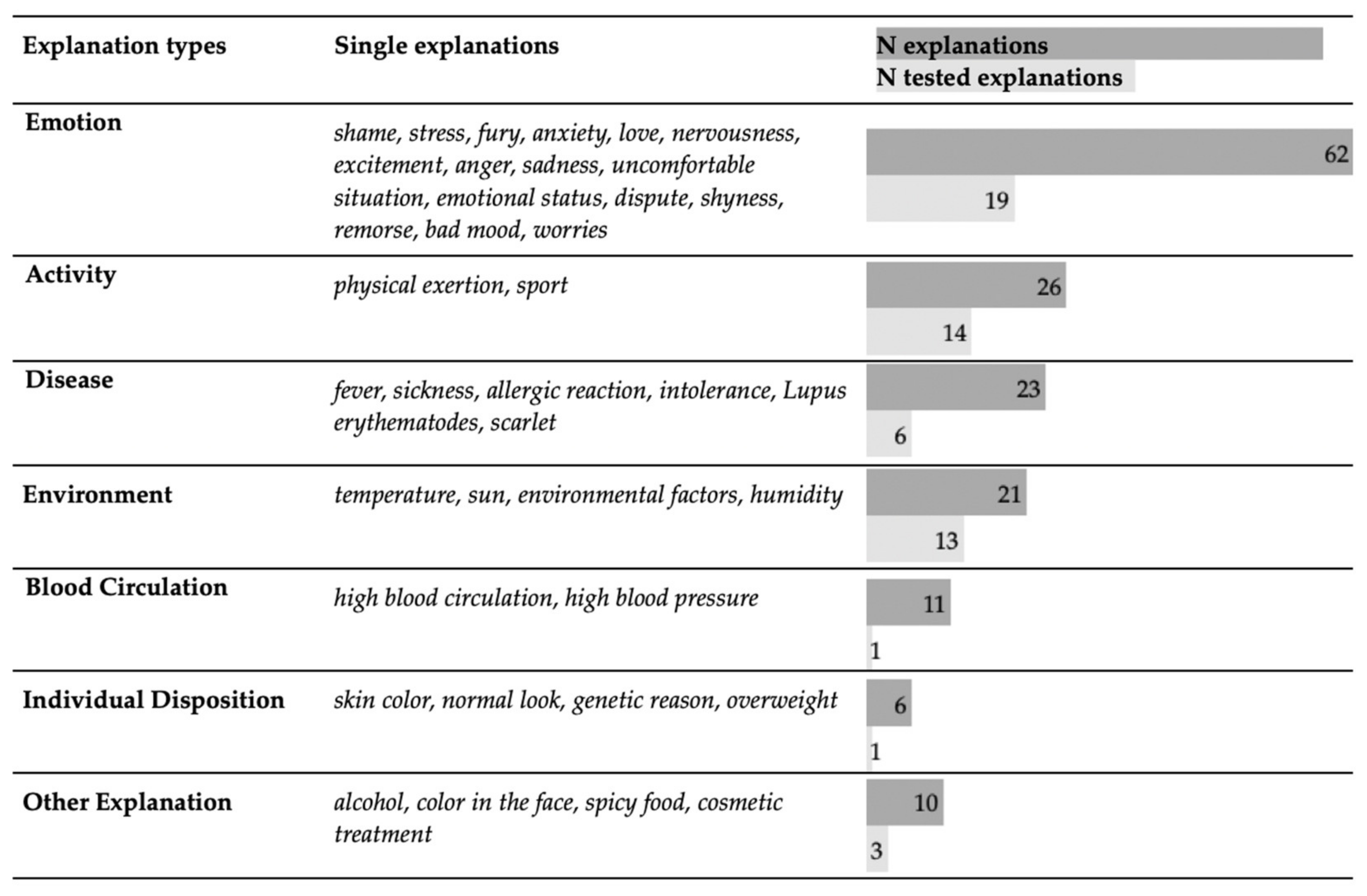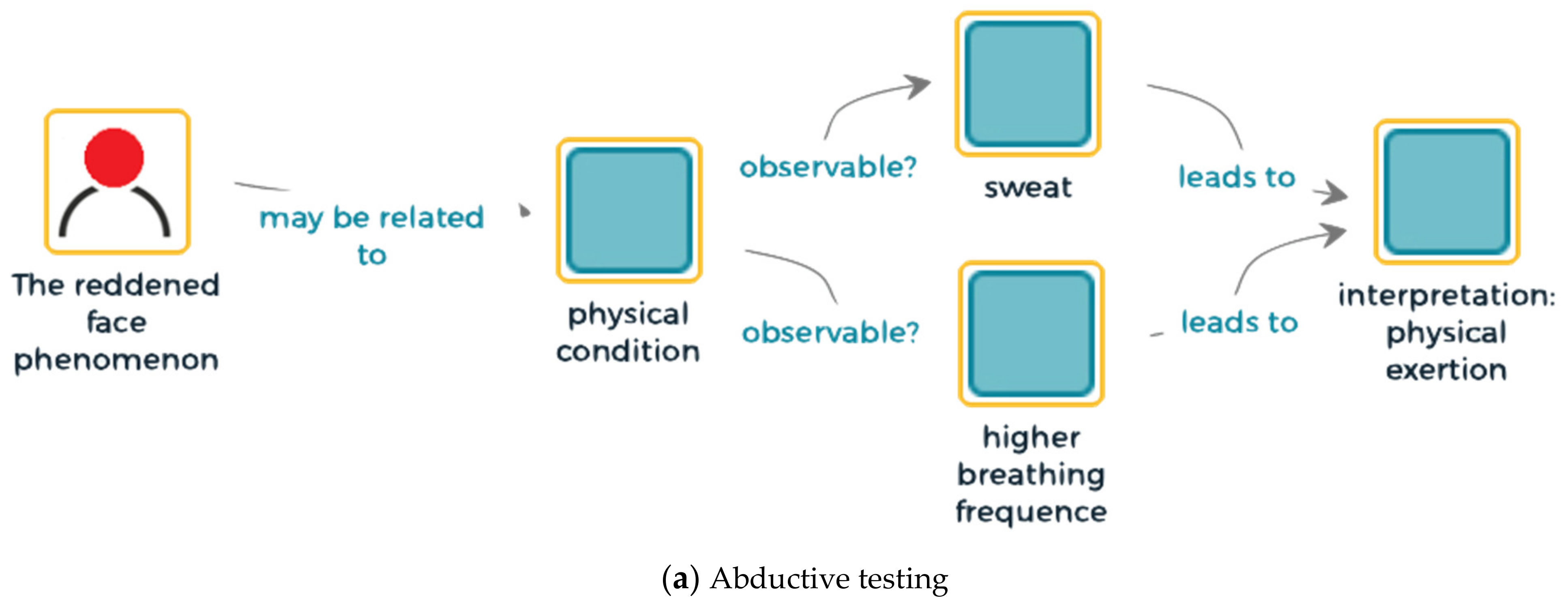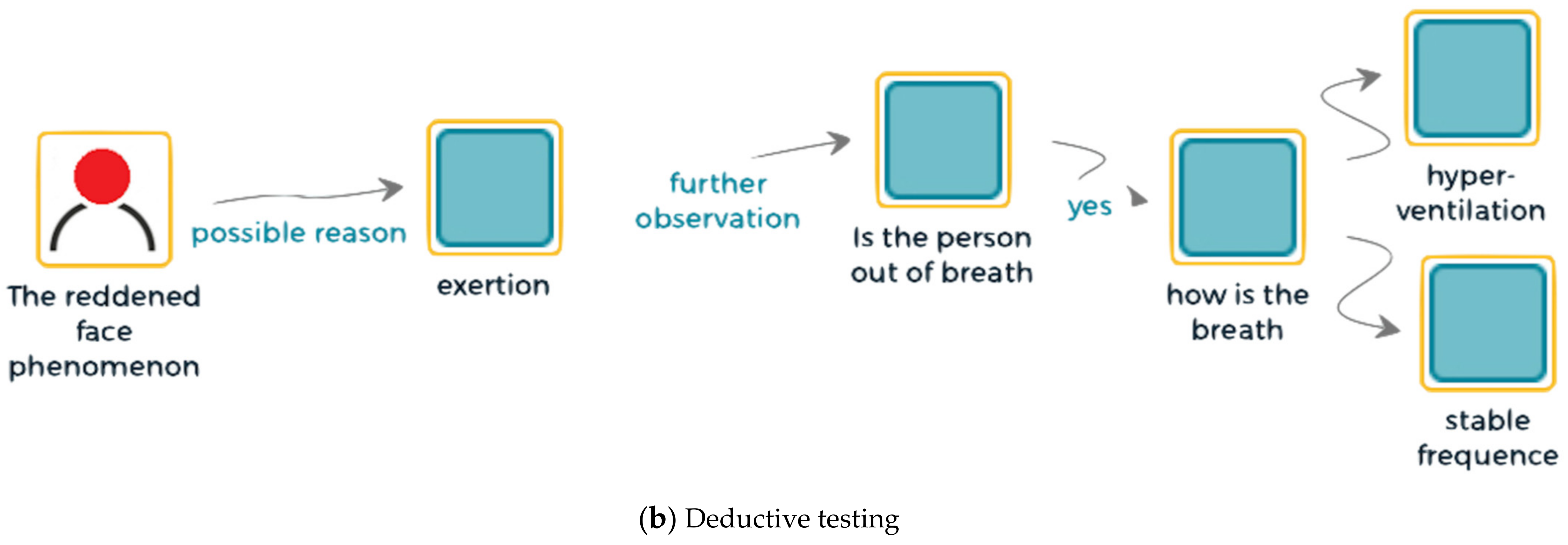Modeling as Scientific Reasoning—The Role of Abductive Reasoning for Modeling Competence
Abstract
:1. Introduction
2. Logical Reasoning
3. Theory of Abductive Reasoning
4. Models and Modeling
4.1. Concept of a Model
“In model-based views, models are considered subsets of scientific theories–more comprehensive systems of explanations–which are created with various semiotic resources and provide semantically rich information for scientific reasoning and problem solving” [27] (p. 1110).
4.2. Concept of Model-Being
4.3. Modeling Process
5. Framework for Modeling Competence
6. State of Research
7. Outlook
Author Contributions
Funding
Informed Consent Statement
Data Availability Statement
Conflicts of Interest
References
- Magnani, L. Model-Based and Manipulative Abduction in Science. Found. Sci. 2004, 9, 219–247. [Google Scholar] [CrossRef]
- Nersessian, N.J. Model-Based Reasoning in Conceptual Change. In Model-Based Reasoning in Scientific Discovery; Magnani, L., Nersessian, N.J., Thagard, P., Eds.; Springer: Boston, MA, USA, 1999; pp. 5–22. ISBN 978-1-4615-4813-3. [Google Scholar]
- Rocksén, M. The Many Roles of “Explanation” in Science Education: A Case Study. Cult. Stud. Sci. Educ. 2016, 11, 837–868. [Google Scholar] [CrossRef]
- Giere, R.; Bickle, J.; Mauldin, R. Understanding Scientific Reasoning; Thomson: London, UK, 2006. [Google Scholar]
- Rychen, D.S.; Salganik, L.H. Key Competencies for a Successful Life and Well-Functioning Society; Hogrefe Publishing: Göttingen, Germany, 2003; ISBN 978-1-61676-272-8. [Google Scholar]
- Upmeier zu Belzen, A.; van Driel, J.; Krüger, D. Introducing a Framework for Modeling Competence. In Towards a Competence-Based View on Models and Modeling in Science Education; Upmeier zu Belzen, A., Krüger, D., van Driel, J., Eds.; Springer International Publishing: Cham, Switzerland, 2019; pp. 3–19. ISBN 978-3-030-30255-9. [Google Scholar]
- Krüger, D.; Upmeier zu Belzen, A. Kompetenzmodell der Modellierkompetenz—Die Rolle abduktiven Schließens beim Modellieren. Z. Für Didakt. Naturwiss. 2021. [Google Scholar] [CrossRef]
- Kind, P.; Osborne, J. Styles of Scientific Reasoning: A Cultural Rationale for Science Education? Sci. Educ. 2017, 101, 8–31. [Google Scholar] [CrossRef] [Green Version]
- Gouvea, J.; Passmore, C. ‘Models’ of versus ‘Models’ for: Toward an Agent-Based Conception of Modeling in the Science Classroom. Sci. Educ. 2017, 26, 49–63. [Google Scholar] [CrossRef]
- Upmeier zu Belzen, A.; Krüger, D. Modellkompetenz Im Biologieunterricht. Z. Für Didakt. Naturwiss. 2010, 16, 41–57. [Google Scholar]
- Krüger, D.; Kauertz, A.; Upmeier zu Belzen, A. Modelle und das Modellieren in den Naturwissenschaften. In Theorien in der Naturwissenschaftsdidaktischen Forschung; Springer: Berlin/Heidelberg, Germany, 2018; pp. 141–157. ISBN 978-3-662-56319-9. [Google Scholar]
- Clement, J. Creative Model Construction in Scientists and Students: The Role of Imagery, Analogy, and Mental Simulation; Springer: Dordrecht, The Netherlands, 2008; ISBN 978-1-4020-6711-2. [Google Scholar]
- Johnson, T.R.; Krems, J.F. Use of Current Explanations in Multicausal Abductive Reasoning. Cogn. Sci. 2001, 25, 903–939. [Google Scholar] [CrossRef]
- Peirce, C.S. [Harvard] Lectures on Pragmatism; Belknap, Harvard: Cambridge, MA, USA, 1978. [Google Scholar]
- Krell, M.; Upmeier Zu Belzen, A.; Krüger, D. Modellkompetenz im Biologieunterricht. In Biologiedidaktische Forschung. Schwerpunkte und Forschungsgegenstände; Sandmann, A., Schmiemann, P., Eds.; Logos: Berlin, Germany, 2016; pp. 83–102. [Google Scholar]
- Krell, M.; Walzer, C.; Hergert, S.; Krüger, D. Development and Application of a Category System to Describe Pre-Service Science Teachers’ Activities in the Process of Scientific Modelling. Res. Sci. Educ. 2019, 49, 1319–1345. [Google Scholar] [CrossRef]
- Gogolin, S.; Krüger, D. Students’ Understanding of the Nature and Purpose of Models. J. Res. Sci. Teach. 2018, 55, 1313–1338. [Google Scholar] [CrossRef]
- Ke, L.; Schwarz, C. Using epistemic considerations in teaching: Fostering students’ meaningful engagement in scientific modeling. In Towards a Competence-Based View on Models and Modeling in Science Education; Upmeier zu Belzen, A., Krüger, D., Driel, J., Eds.; Springer: Cham, Switzerland, 2019. [Google Scholar]
- Kampourakis, K.; Niebert, K. Explanation in biology education. In Teaching Biology in Schools: Global Research, Issues, and Trends; Kampourakis, K., Reiss, M.J., Eds.; CRC Press: New York, NY, USA, 2018; pp. 237–248. ISBN 978-1-138-08798-9. [Google Scholar]
- Park, J.H.; Lee, K.-H. How Can Mathematical Modeling Facilitate Mathematical Inquiries? Focusing on the Abductive Nature of Modeling. Eurasia J. Math. Sci. Technol. Educ. 2018, 14, em1587. [Google Scholar] [CrossRef]
- Oh, P.S. How Can Teachers Help Students Formulate Scientific Hypotheses? Some Strategies Found in Abductive Inquiry Activities of Earth Science. Int. J. Sci. Educ. 2010, 32, 541–560. [Google Scholar] [CrossRef]
- Oh, P.S. Features of Modeling-Based Abductive Reasoning as a Disciplinary Practice of Inquiry in Earth Science. Sci. Educ. 2019, 28, 731–757. [Google Scholar] [CrossRef]
- Harman, G. The Inference to the Best Explanation. Philos. Rev. 1965, 74. [Google Scholar] [CrossRef]
- Wirth, U. Die Phantasie Des Neuen Als Abduktion. Dtsch. Vierteljahrsschr. Für Lit. Geistesgesch. 2003, 77. [Google Scholar] [CrossRef] [Green Version]
- Krems, J.; Johnson, T.; Kliegl, R. Kognitive Komplexität und abduktives Schließen. In Strukturen und Prozesse Intelligenter Systeme; Kluwe, R.H., Ed.; Deutscher Universitätsverlag: Wiesbaden, Germany, 1997. [Google Scholar]
- Johnson, T.R.; Krems, J.; Amra, N.K. A computational model of human abductive skill and its acquisition. In Proceedings of the Sixteenth Annual Conference of the Cognitive Science Society; Ram, A., Eiselt, K., Eds.; Erlbaum: Hillsdale, MI, USA, 1994. [Google Scholar]
- Oh, P.S.; Oh, S.J. What Teachers of Science Need to Know about Models: An Overview. Int. J. Sci. Educ. 2011, 33, 1109–1130. [Google Scholar] [CrossRef]
- Mahr, B. Information Science and the Logic of Models. Softw. Syst. Model. 2009, 8, 365–383. [Google Scholar] [CrossRef]
- Agassi, J. Why there is no theory of models. In Theories and Models in Scientific Processes. Proceedings of AFOS ‘94 Workshop, August 15–26, Madralin and IUHPS ‘94 Conference, August 27–29, Warszawa; Herfel, W., Krajewski, W., Niiniluoto, I., Wójcicki, R., Eds.; Rodopi: Amsterdam, The Netherlands, 1995; pp. 17–26. [Google Scholar]
- Gilbert, J.K.; Justi, R. Modelling-Based Teaching in Science Education; Models and Modeling in Science Education; Springer International Publishing: Cham, Switzerland, 2016; ISBN 978-3-319-29038-6. [Google Scholar]
- Ritchey, T. Outline for a Morphology of Modelling Methods. Acta Morphol. Gen. AMG 2012, 1, 1012. [Google Scholar]
- Mittelstraß, J. Anmerkungen zum Modellbegriff. In Modelle des Denkens: Streitgespräch in der Wissenschaftlichen Sitzung der Versammlung der Berlin-Brandenburgischen Akademie der Wissenschaften am 12. Dezember; Berlin-Brandenburgische Akademie der Wissenschaften: Berlin, Germany, 2005. [Google Scholar]
- Stachowiak, H. Allgemeine Modelltheorie; Springer: Wien, Austria, 1973. [Google Scholar]
- Mahr, B. Modelle Und Ihre Befragbarkeit Grundlagen Einer Allgemeinen Modelltheorie. Erwäg. Wissen Ethik 2015, 26, 329–342. [Google Scholar]
- Harré, R. The Principles of Scientific Thinking; Macmillan: London, UK, 1970. [Google Scholar]
- Passmore, C.; Gouvea, J.S.; Giere, R. Models in Science and in Learning Science: Focusing Scientific Practice on Sense-making. In International Handbook of Research in History, Philosophy and Science Teaching; Matthews, M.R., Ed.; Springer Netherlands: Dordrecht, The Netherlands, 2014; pp. 1171–1202. ISBN 978-94-007-7654-8. [Google Scholar]
- Mahr, B. Ein Modell des Modellseins. In Modelle; Dirks, U., Knobloch, E., Eds.; Peter Lang: Frankfurt am Main, Germany, 2008. [Google Scholar]
- Mäki, U. Models Are Experiments, Experiments Are Models. J. Econ. Methodol. 2005, 12, 303–315. [Google Scholar] [CrossRef]
- Mahr, B. On the Epistemology of Models; De Gruyter: Boston, MA, USA, 2012; pp. 301–352. ISBN 978-3-11-025357-3. [Google Scholar]
- Morrison, M.; Morgan, M.S. Introduction. In Models as Mediators. Perspectives on Natural and Social Science; Morgan, M.S., Morrison, M., Eds.; Cambridge University Press: Cambridge, UK, 1999. [Google Scholar]
- Schurz, G. Patterns of Abduction. Synthese 2008, 164, 201–234. [Google Scholar] [CrossRef]
- Popper, K. Logik Der Forschung; Mohr Siebeck: Tübingen, Germany, 2005. [Google Scholar]
- Langlet, J. Kultur der Naturwissenschaften. In Fachdidaktik Biologie; Gropengießer, H., Harms, U., Kattmann, U., Eds.; Aulis: Hallbergmoos, Germany, 2016. [Google Scholar]
- Greve, W.; Wentura, D. Wissenschaftliche Beobachtung. Eine Einführung; Beltz: Weinheim, Germany, 1997. [Google Scholar]
- Upmeier zu Belzen, A.; Krüger, D. Modelle Und Modellieren Im Biologieunterricht: Ein Fall Für Erkenntnisgewinnung. Unterr. Chem. 2019, 171, 38–41. [Google Scholar]
- Bailer-Jones, D.M. Tracing the Development of Models in the Philosophy of Science. In Model-Based Reasoning in Scientific Discovery; Magnani, L., Nersessian, N.J., Thagard, P., Eds.; Springer: Boston, MA, USA, 1999; pp. 23–40. ISBN 978-1-4615-4813-3. [Google Scholar]
- Knuuttila, T. Modelling and Representing: An Artefactual Approach to Model-Based Representation. Stud. Hist. Philos. Sci. Part A 2011, 42, 262–271. [Google Scholar] [CrossRef]
- Grosslight, L.; Unger, C.; Jay, E.; Smith, C.L. Understanding Models and Their Use in Science: Conceptions of Middle and High School Students and Experts. J. Res. Sci. Teach. 1991, 28, 799–822. [Google Scholar] [CrossRef]
- Justi, R.S.; Gilbert, J.K. Modelling, Teachers’ Views on the Nature of Modelling, and Implications for the Education of Modellers. Int. J. Sci. Educ. 2002, 24, 369–387. [Google Scholar] [CrossRef]
- Crawford, B.; Cullin, M. Dynamic Assessments of Preservice Teachers’ Knowledge of Models and Modelling. In Research and the Quality of Science Education; Boersma, K., Goedhart, M., de Jong, O., Eijkelhof, H., Eds.; Springer: Dordrecht, The Netherlands, 2005; pp. 309–323. ISBN 978-1-4020-3673-6. [Google Scholar]
- Priemer, B.; Eilerts, K.; Filler, A.; Pinkwart, N.; Rösken-Winter, B.; Tiemann, R.; Zu Belzen, A.U. A Framework to Foster Problem-Solving in STEM and Computing Education. Res. Sci. Technol. Educ. 2019, 38, 105–130. [Google Scholar] [CrossRef]
- Krems, J.; Johnson, T. Integration of anomalous data in multicausal explanations. In Proceedings of the 1995 Annual Conference of the Cognitive Science Society; Moore, J.D., Lehman, J.F., Eds.; Erlbaum: Hillsdale, MI, USA, 1995. [Google Scholar]
- Krüger, D.; Krell, M. Maschinelles Lernen mit Aussagen zur Modellkompetenz. Z. Für Didakt. Naturwiss. 2020, 26, 157–172. [Google Scholar] [CrossRef]
- Clement, J.; Núñez-Oviedo, M.C. Abduction and Analogy in Scientific Model Construction. In Proceedings of the Annual Meeting of the National Association for Research in Science Teaching, Philadelphia, PA, USA, 23–26 March 2003. [Google Scholar]
- Sturm, G. Abduktion. In Methoden der Politikwissenschaft. Neuere Qualitative und Quantitative Analyseverfahren; Behnke, J., Gschwend, T., Schindler, D., Schnapp, K.-U., Eds.; Nomos: Baden-Baden, Germany, 2006. [Google Scholar]
- Göhner, M.; Krell, M. Preservice Science Teachers’ Strategies in Scientific Reasoning: The Case of Modeling. Res. Sci. Educ. 2020. [Google Scholar] [CrossRef]
- Göhner, M.; Krell, M. Modellierungsprozesse von Lehramtsstudierenden Der Biologie. Erkenn. Biol. 2018, 17, 45–61. [Google Scholar]
- Göhner, M.; Krell, M. Was ist schwierig am Modellieren? Identifikation und Beschreibung von Hindernissen in Modellierungsprozessen von Lehramtsstudierenden naturwissenschaftlicher Fächer. Z. Für Didakt. Naturwiss. 2021. [Google Scholar] [CrossRef]
- Reichertz, J. Die Abduktion in der Qualitativen Sozialforschung: Über die Entdeckung des Neuen; Springer: Wiesbaden, Germany, 2013; Qualitative Sozialforschung; 2., aktualisierte und erw. Aufl; ISBN 978-3-531-93163-0. [Google Scholar]
- Lehrer, R.; Schauble, L. The development of scientific thinking. In Handbook of Child Psychology and Developmental Science: Cognitive Processes, 7th ed.; John Wiley & Sons, Inc.: Hoboken, NJ, USA, 2015; Volume 2, pp. 671–714. ISBN 978-1-118-13678-2. [Google Scholar]
- Heering, P.; Kremer, K. Nature of science. In Theorien in der Naturwissenschaftsdidaktischen Forschung; Krüger, D., Parchmann, I., Schecker, H., Eds.; Springer: Berlin/Heidelberg, Germany, 2018. [Google Scholar]
- Mayer, J. Erkenntnisgewinnung als wissenschaftliches Problemlösen. In Theorien in der Biologiedidaktischen Forschung: Ein Handbuch für Lehramtsstudenten und Doktoranden; Krüger, D., Vogt, H., Eds.; Springer: Berlin/Heidelberg, Germany, 2007; pp. 177–186. [Google Scholar]
- Gut-Glanzmann, C.; Mayer, J. Experimentelle Kompetenz. In Theorien in der Naturwissenschaftsdidaktischen Forschung; Krüger, D., Parchmann, I., Schecker, H., Eds.; Springer: Berlin/Heidelberg, Germany, 2018. [Google Scholar]
- Evans, J.S.B. Logic and Human Reasoning: An Assessment of the Deduction Paradigm. Psychol. Bull. 2002, 128, 978–996. [Google Scholar] [CrossRef]





Publisher’s Note: MDPI stays neutral with regard to jurisdictional claims in published maps and institutional affiliations. |
© 2021 by the authors. Licensee MDPI, Basel, Switzerland. This article is an open access article distributed under the terms and conditions of the Creative Commons Attribution (CC BY) license (https://creativecommons.org/licenses/by/4.0/).
Share and Cite
Upmeier zu Belzen, A.; Engelschalt, P.; Krüger, D. Modeling as Scientific Reasoning—The Role of Abductive Reasoning for Modeling Competence. Educ. Sci. 2021, 11, 495. https://doi.org/10.3390/educsci11090495
Upmeier zu Belzen A, Engelschalt P, Krüger D. Modeling as Scientific Reasoning—The Role of Abductive Reasoning for Modeling Competence. Education Sciences. 2021; 11(9):495. https://doi.org/10.3390/educsci11090495
Chicago/Turabian StyleUpmeier zu Belzen, Annette, Paul Engelschalt, and Dirk Krüger. 2021. "Modeling as Scientific Reasoning—The Role of Abductive Reasoning for Modeling Competence" Education Sciences 11, no. 9: 495. https://doi.org/10.3390/educsci11090495






